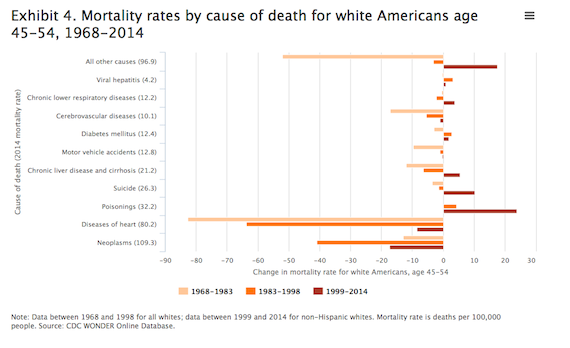Why the White Working Class Rebelled
The Democratic Party has been the Establishment for eight years, and the Clintons have arguably been the Establishment for 24 years. Since the late 1990s, members of the white working class with high school or less have seen their life-chances radically decline, even to the point where they are dying at much higher rates than they have a right to expect.
A year ago Anne Case and Angus Deaton, Princeton University economists, published a study with the startling finding that since 1999 death rates have been going up for white Americans aged 45-54. It is even worse than it sounds, since death rates were declining for the general population.
One of the big reasons for this increased death rate has been increased use of opiods and other drugs, leading to overdoses, along with liver disease from drinking too much alcohol and increased suicide rates. The problems were especially acute among working class and rural whites with only high school or less, and later studies found that they extended to younger members of this social class in their 20s and 30s. Loss of good-paying manufacturing jobs was clearly a primary reason for this despair.
Compared to 1999, white workers, according to another recent study in the Commonwealth Foundation: “have lower incomes, fewer are employed, and fewer are married.” This study found other causes for the increased death rates than just the ones mentioned above, but didn’t deny the Princeton findings. Here is their chart:

The only comparison I can think of to this situation is what happened to Russians in the 1990s after the collapse of the Soviet Union. The Russian Federation had a population of nearly 150 million in 1990 and thereafter fell to about 144 million. The end of the Soviet Union caused their confidence in the future to collapse and the end of the old economic system created very high unemployment. They stopped having children and drank themselves to death.
Neoliberalism– putting the market in charge of social policy and actually encouraging industries to move abroad for higher profit margins (but for fewer industrial jobs at home)– had much the same effect on the white working class as the fall of the Soviet system had on the Russian working class. Look at what happened to the proportion of the US economy accounted for by industry when Neoliberal policies became dominant:
 h/t MinnPost
h/t MinnPost
People who argue that the working class in the US is coddled, with too many benefits and is too well-paid infuriate me. German workers have good benefits and pay, and German industry is thriving in a way that American industry is not. It is about the overall policies enacted by the government.
And consider these conclusions of Mark Levinson of the Congressional Research Service:
*”The United States’ share of global manufacturing activity declined fro m 28% in 2002, following the end of the 2001 U.S. recession, to 16.5% in 2011 . Since then, the U.S. share has risen to 17.2%. These estimates are based on the value of each country’s manufacturing in U.S. dollars ; part of the decline in the U.S. share was due to a 23% decline in the value of the dollar between 2002 and 2011, and part of the rise since 2011 is attributable to a stronger dollar.
* “China displaced the United States as the largest manufacturing country in 2010 . Again, part of China’s rise by this measure has been due to the appreciation of its currency, the renminbi , against the U.S. dollar.
*Manufacturing output , measured in each country’s local currency adjusted for inflation, has grown more slowly in the United States over the past decade than in China, Japan, Germany, and Mexico.”
And among the prime operators of the Neoliberal system were the Clintons.
There is an intervening irony. The one thing that helped working class whites with their increasing health problems was Obamacare. But that help was blunted by the Republican statehouses that refused to support it. So some of the rage of the workers about Obamacare was connived at by the GOP, which didn’t want them to have health care in the first place. (The GOP only really represents big business, which didn’t want to pay for it).
The rage of these workers accounted for the unpredictability of the 2016 election, since they voted in very large numbers for Donald Trump. (There were lots of other constituencies for Trump, but many of them were longstanding GOP groups; the white working class mostly voted Democratic). What appealed to them in Trump’s message was
1. protectionism and slamming trade partners like China and Japan, which Trump and his audience saw as having gained unfair advantages
2. Attacks on NAFTA and TPP and making an issue of industries and jobs lost to Mexico and China.
3. Attacks on Hillary Clinton over her massively well paid speeches to the big banks on Wall Street, whose shenanigans had cost many in the white working class their homes.
4. Anti-immigrant sentiment, the sense of losing jobs and cultural supremacy to incoming workers.
The Democratic Party’s refusal to do anything about Wall Street mega-fraud in 2009 and after came home to roost. In other words, the Clintons were inextricably entangled in the very policies that white workers saw as having ruined their lives. And objectively speaking, they weren’t wrong.
And the white working class punished the Democratic Party for not being a Left party.